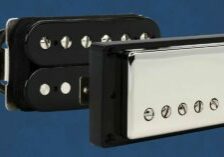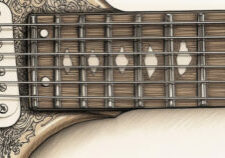The cost to ship a guitar is usually one of the first things that keep people from listing guitars on online marketplaces. If you are planning to ship your guitar to a friend or customer but are not sure how much it will cost, then we’ll be able to provide some great information here that will be helpful in your shipping journey.
Shipping a guitar is unlike shipping any other item, as it requires special handling and packaging. It’s obviously much larger so it takes more time to pack. And the pricing of shipping can change dramatically based on your location along with the destination.
Cost to Ship a Guitar
I’ve shipped dozens of guitars from the Midwest to various cities in the lower 48 states in the last few years. So I do have the benefit of never having to ship more than the distance of about 50% of the US. On average, a properly packed box that contains a guitar will cost $50 – $80 to ship. This would be for a standard ground delivery (not priority) and includes shipping material and carrier fees.
The cost of shipping a guitar depends on multiple factors, such as weight, destination, type of service, packing materials, and insurance coverage. In this article, we will discuss the various factors that affect the cost of shipping a guitar and provide you with tips on how to save money while ensuring safe delivery.
It’s also worth noting that different shipping services have varying rates based on location. In my location, UPS beats out Fedex and USPS almost every single time. This may not be the case in your location, so you need to get quotes from all the major carriers.
Key Takeaways
- The cost of shipping a guitar depends on weight, destination, service type, and insurance coverage. Heavier and larger guitars may cost more and require additional fees, especially for international shipments due to customs fees and taxes.
- Proper packaging is essential for protecting the guitar during transit, and factors affecting cost include shipping distance, guitar size, and packaging. A hard case that fits snugly and has good padding and locking mechanisms is the best option.
- When comparing shipping prices, it’s important to consider carrier reputation, delivery time frame, insurance coverage/liability protection plan, and tracking capability.
- International shipping rates are higher due to customs clearance and duties.
- Adding foam padding or bubble wrap can help absorb shocks or vibrations during transport, and securing all loose parts is crucial to prevent damage.
Factors Affecting Guitar Shipping Costs
You’ll want to consider several factors when figuring out how much it’ll cost to ship your guitar. The carrier, shipping distance, guitar size, and packaging are the most important factors that affect the cost of shipping a guitar.
Shipping distance is one of the biggest factors to consider when calculating the cost of shipping a guitar. The further you need to ship your guitar, the more expensive it will be. I shipped a Fender strat in a case from Illinois to California that cost exactly twice as much as shipping the same guitar to Ohio (Same sized case, box and weight).
Guitar size can be a factor. Normally, the box is still big no matter what the size of guitar but shipping a smaller guitar without a case will be a bit cheaper than a large guitar with a heavy case.
Compare Shipping Prices
Shipping companies offer different rates depending on the weight, size, and distance of the package. Moreover, international shipping will cost you more than domestic shipping due to customs fees and taxes.
To give you an idea of the price range for domestic guitar shipping, here are some popular carriers’ estimates: UPS charges around $30-$100 while FedEx charges slightly higher at approximately $60-$120. On the other hand, USPS offers cheaper options in many with a rate of about $30-$70. However, keep in mind that these rates may vary based on location and additional services such as insurance or overnight delivery.
Another point to consider is whether you sell your guitar through Reverb or eBay. Both Reverb and eBay will enable you to get discounted rates that you won’t be buying directly from these shipping companies. On Reverb, I tend to get better rates from UPS. Its also beneficial to me that there are several UPS stores that allow me to drop off boxes when USPS is closed (like on a Sunday).
When it comes to international guitar shipping, expect to pay more due to customs clearance and duties imposed by each country. Professional guitar shippers like DHL or Fedex International offer door-to-door service with tracking information and insurance coverage but can cost up to several hundred dollars depending on the destination.
Shipping a guitar can be costly and stressful but knowing your options can help ease some of that burden. Take note of these factors when comparing shipping prices: carrier reputation, delivery time frame, insurance coverage/liability protection plan (if any), tracking capability/real-time status updates during transit.
Pack Your Guitar Properly
When it comes to packing your guitar properly, there are a few key points you’ll want to keep in mind.
First, use a hard case to protect your instrument If you can. This can definitely help you avoid shipping. If you don’t have a case, you can still ship it but you will need need to use a lot of bubble wrap and space fillers.
Second, I like to remove all loose parts and put them in a single box or wrap them up together so they don’t bang around. No one wants a tremolo arm putting dings in the guitar finish. Don’t just put them in a case compartment as that compartment can open up and still cause the loose pieces to bang around.
I like to loosen all the guitar strings. I also tape some paper between the neck and the strings. This might be a bit overkill but I’ve seen this done and I think its worth the extra time.
Shipping with a case
Even a case, the guitar can move around so I always put some bubble wrap around the headstock and neck. I try to fill any other space with bubble wrap and then lightly shake the box. You should not feel the guitar move at all.
Then I put bubble wrap around the case. I then use packing paper to fill all the space and like to use boxes with extra space. Foam is also a good space filler if you can get access to some foam. Again, lightly shake the box and make sure you can’t feel the case moving or rattling inside the box.
Shipping without a case
When I ship a guitar without a case, I fully wrap it several times in bubble wrap. Then tape the bubble wrap so it won’t slide off. I add extra wrap at each end and do additional wraps around the neck.
When not using a case, I do not use paper. I only use bubble wrap. I will put a lot of wrap in the bottom of the box. Usually about 6-8 inches of bubble wrap. The put the guitar in the box. Next I’ll start filling the sides in with bubble wrap. My goal is to try to have the guitar right in the middle of the box.
I’ve shipped over 50 guitars in the last 3 years and have had no damages with more than half of them shipped without a case. But it is worth noting that if the carrier mistreats the box, there is nothing you an do. Bubble wrap is no match for a box thats been thrown over a fence or punctured by a forklift!
Remember to Secure Loose Parts
To make sure your guitar arrives at its destination without any damage, you must secure all loose parts before shipping. This is crucial to prevent the instrument from getting scratched, dented or broken during transit.
You can start by removing any detachable parts such as the strap buttons or tremolo arm and packing them separately in a plastic bag. Then, tighten all screws and bolts on the guitar body including those that hold the pickups, tuning machines, and bridge.
Tips for tightening screws include using an appropriate screwdriver size to avoid stripping the threads and checking for any stripped holes before securing them back in place. You should also be careful not to overtighten as this could cause damage to the wood or strip the screw threads entirely.
When I have loose parts wrapped in bubble wrap, I always wrap some paper around them and label them so they don’t get thrown out with other packing material.
Label Your Package Correctly
When shipping a guitar, it’s important to label your package correctly to ensure its safe arrival at its destination. Put the packing slip in the box and I like to make sure I add the list of loose items on the packing slip.
First, be sure to include your return address on the package in case it needs to be returned for any reason.
Second, clearly label the box as ‘fragile’ so that handlers know to handle with care. I write FRAGILE all over each side of the box in huge letters.
Finally, don’t forget to include insurance information in case of damage or loss during transit.
Taking these steps can help ensure that your guitar arrives safely and securely at its destination.
Case Candy & Other Goodies
If I sell a nice guitar worth more than $500, I usually though in some picks, guitar strings, a book, a capo. I’ve even thrown in some actual candy.
The comments I get in response to this is really cool and if there’s a problem, I think it can set the right tone.
I mean, I just think it a cool to add some extras as its such a fun day for someone to get a new guitar. Makes me feel good to help one of my brothers or sisters.
Consider Shipping Insurance
When you’re shipping a guitar, then consider purchasing shipping insurance.
I always insure any guitar I ship thats worth more than $300. Its not that expensive and its worth it to me.
Shipping a Guitar: Conclusion
Congratulations! You now know how to safely ship your guitar and make this an exciting day for your fellow guitarists.
I’ve seen a lot of people claim that you can’t ship guitars safely and eventually, you will have damage. But I don’t agree. If you are smart about how you pack your guitar, you won’t have to deal with damage that often. There are companies shipping out thousands of guitars a day, so if they can do it, you can do it!





